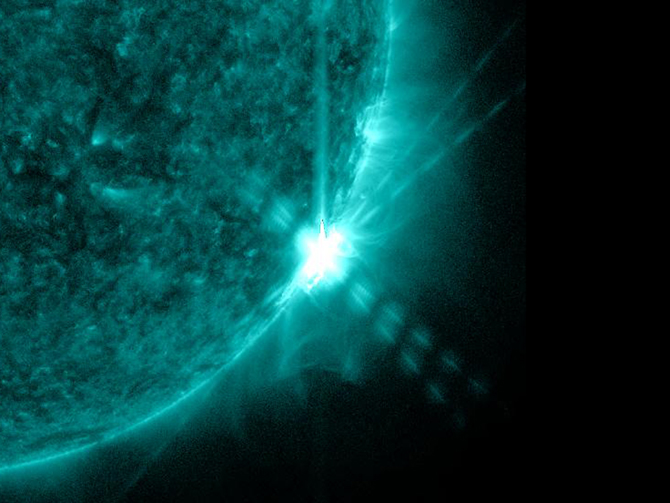The Sun Emits an M5.9 Solar Flare
06.08.13

An M-class flare appears on the lower right of the sun on June 7,
2013. This image was captured by NASAís Solar Dynamics Observatory
in the 131 Angstrom wavelength, a wavelength of UV light that is
particularly good for seeing flares and that is typically colorized
in teal. Caption: NASA/SDO
The sun emitted a mid-level solar flare, peaking at 6:49 p.m. on June 7, 2013. Solar flares are powerful bursts of radiation. Harmful radiation from a flare cannot pass through Earth's atmosphere to physically affect humans on the ground, however -- when intense enough -- they can disturb the atmosphere in the layer where communications signals travel. This disrupts the radio signals for as long as the flare is ongoing, anywhere from minutes to hours.
This flare is classified as an M5.9 flare. M-class flares are the weakest flares that can still cause some space weather effects near Earth. This flare caused a moderate radio blackout, rated an R2 on the National Oceanic and Atmospheric Administrationís space weather scales, which range from R1 to R5. It has since subsided.
Increased numbers of flares are quite common at the moment, since the sun's normal 11-year activity cycle is ramping up toward solar maximum, which is expected in late 2013. Humans have tracked this solar cycle continuously since it was discovered in 1843, and it is normal for there to be many flares a day during the sun's peak activity. NOAA's Space Weather Prediction Center (http://swpc.noaa.gov) is the U.S. government's official source for space weather forecasts, alerts, watches and warnings.
Updates will be provided as they are available on the flare.
http://www.nasa.gov/mission_pages/sunearth/news/News060813-m5.9flare.html